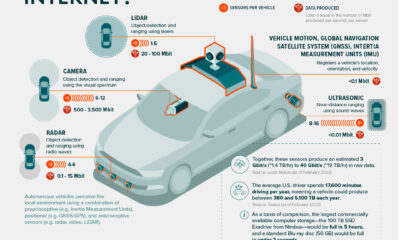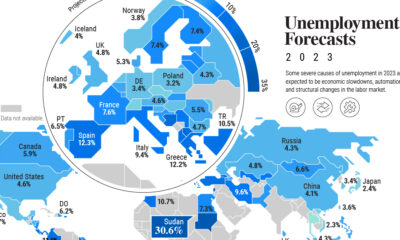With 5G, we’re on the cusp of a similar transition in the global communications system. Total connectivity could soon be at our fingertips. Today’s infographic breaks down the potential that 5G promises, and the immense opportunities stemming from its implications for smart tech and the Internet of Things (IoT).
A Timeline of Wireless Generations
The world’s appetite for wireless speed has been insatiable. We’ve powered through five generations of wireless connectivity in just 40 years.
1982-1990s: Analog 1G 1G only supported voice calls, and little else. Data bandwidth: 1.9 kbps 1990s: Digital 2G 2G supported text, picture, and multimedia messaging (SMS, MMS). Data bandwidth: 14.4 kbps – 384 kbps 2000s: 3G Smartphone Era The first 3G networks go online, supporting high-quality audio and video, and international roaming. Data bandwidth: 2 Mbps 2010: 4G Streaming Era 4G and LTE supported HD video streaming, and is deployed in Europe, and later in the U.S. Data bandwidth: 2 Mbps – 1 Gbps 2019-Present: Full Speed Ahead to 5G? South Korea first launches 5G across the country, followed by 50 cities in China. The U.S., UK, and Germany also roll out 5G on a limited basis. Data bandwidth: 1 Gbps – >10 Gbps *k/M/Gbps: kilobytes/ megabytes/ gigabytes per second.
The global 5G market is projected to reach $668 billion at a 122% compound annual growth rate (2020-2026), with nearly half this growth coming from Asia-Pacific.
4G versus 5G: What’s the Difference?
5G is on the verge of taking off. What sets it apart from its predecessor? For starters, 5G’s speed improvements are something to behold—it is up to 20x faster than 4G. On 4G, an average movie takes 6 minutes to download. With 5G, it will take less than 20 seconds. In other benefits, 5G supports 10x more devices per square kilometer. As a result, 5G will be able to seamlessly handle many more devices, within the same area as before. This is pivotal for its use in the imminent Internet of Things (IoT). Finally, latency is the delay (lag), or the time that it takes to send data from point A to point B. With 5G, latency plunges 25x compared to 4G. This results in almost instantaneous data transfers. —Morgan Stanley
Beyond the Smartphone
5G is one of the most anticipated technologies of our time, and with good reason. In the coming years, the partnership between 5G and the IoT could bring about a boom in smart tech, and this effect could trickle into growth for the economy and investor portfolios. The 5G network is the perfect backbone for the IoT—supporting increasing device numbers, facilitating growing data transfers, and improving response time among connected devices. According to McKinsey, 5G will likely speed up the mainstream adoption of the IoT across multiple industries:
1. Transport
5G enables self-driving cars to make “split second” decisions, making them safer. These cars can also connect to buildings, street lights, other cars, and even pedestrians in smart cities—responding rapidly to any issues and improving traffic flow. These two use cases are estimated to bring a $170-$280 billion global GDP boost to the mobility sector by 2030.
2. Manufacturing
5G could usher in high-tech industry, using AR/VR to boost productivity and precision. Analytics and advanced robotics in smart factories can streamline manufacturing processes, leading to efficiency gains and cost savings. Altogether, the impact could be a $400-$650 billion GDP boost to the industry by 2030.
3. Healthcare
While robotic surgeries are not new, 5G could allow these procedures to occur remotely. Wearables and other smart medical devices provide real-time updates on patients, and make accurate diagnoses. These two applications will contribute an additional $250-$450 billion in GDP to the healthcare space by 2030.
A New Wireless Era
5G is only scratching the surface of its full potential, though a few caveats remain before it can scale successfully. A whole new lineup of infrastructure will be needed to support this latest wireless generation, including enabled devices, network density and access, and getting telecoms operators and carriers on board. The complete uptake of 5G will take a few years to realize. But as the technological shift continues to unfold, investors can take advantage of the wave of opportunities it presents. 5G is more than an upgrade—it’s a crucial transformation of major segments of the economy. on But fast forward to the end of last week, and SVB was shuttered by regulators after a panic-induced bank run. So, how exactly did this happen? We dig in below.
Road to a Bank Run
SVB and its customers generally thrived during the low interest rate era, but as rates rose, SVB found itself more exposed to risk than a typical bank. Even so, at the end of 2022, the bank’s balance sheet showed no cause for alarm.
As well, the bank was viewed positively in a number of places. Most Wall Street analyst ratings were overwhelmingly positive on the bank’s stock, and Forbes had just added the bank to its Financial All-Stars list. Outward signs of trouble emerged on Wednesday, March 8th, when SVB surprised investors with news that the bank needed to raise more than $2 billion to shore up its balance sheet. The reaction from prominent venture capitalists was not positive, with Coatue Management, Union Square Ventures, and Peter Thiel’s Founders Fund moving to limit exposure to the 40-year-old bank. The influence of these firms is believed to have added fuel to the fire, and a bank run ensued. Also influencing decision making was the fact that SVB had the highest percentage of uninsured domestic deposits of all big banks. These totaled nearly $152 billion, or about 97% of all deposits. By the end of the day, customers had tried to withdraw $42 billion in deposits.
What Triggered the SVB Collapse?
While the collapse of SVB took place over the course of 44 hours, its roots trace back to the early pandemic years. In 2021, U.S. venture capital-backed companies raised a record $330 billion—double the amount seen in 2020. At the time, interest rates were at rock-bottom levels to help buoy the economy. Matt Levine sums up the situation well: “When interest rates are low everywhere, a dollar in 20 years is about as good as a dollar today, so a startup whose business model is “we will lose money for a decade building artificial intelligence, and then rake in lots of money in the far future” sounds pretty good. When interest rates are higher, a dollar today is better than a dollar tomorrow, so investors want cash flows. When interest rates were low for a long time, and suddenly become high, all the money that was rushing to your customers is suddenly cut off.” Source: Pitchbook Why is this important? During this time, SVB received billions of dollars from these venture-backed clients. In one year alone, their deposits increased 100%. They took these funds and invested them in longer-term bonds. As a result, this created a dangerous trap as the company expected rates would remain low. During this time, SVB invested in bonds at the top of the market. As interest rates rose higher and bond prices declined, SVB started taking major losses on their long-term bond holdings.
Losses Fueling a Liquidity Crunch
When SVB reported its fourth quarter results in early 2023, Moody’s Investor Service, a credit rating agency took notice. In early March, it said that SVB was at high risk for a downgrade due to its significant unrealized losses. In response, SVB looked to sell $2 billion of its investments at a loss to help boost liquidity for its struggling balance sheet. Soon, more hedge funds and venture investors realized SVB could be on thin ice. Depositors withdrew funds in droves, spurring a liquidity squeeze and prompting California regulators and the FDIC to step in and shut down the bank.
What Happens Now?
While much of SVB’s activity was focused on the tech sector, the bank’s shocking collapse has rattled a financial sector that is already on edge.
The four biggest U.S. banks lost a combined $52 billion the day before the SVB collapse. On Friday, other banking stocks saw double-digit drops, including Signature Bank (-23%), First Republic (-15%), and Silvergate Capital (-11%).
Source: Morningstar Direct. *Represents March 9 data, trading halted on March 10.
When the dust settles, it’s hard to predict the ripple effects that will emerge from this dramatic event. For investors, the Secretary of the Treasury Janet Yellen announced confidence in the banking system remaining resilient, noting that regulators have the proper tools in response to the issue.
But others have seen trouble brewing as far back as 2020 (or earlier) when commercial banking assets were skyrocketing and banks were buying bonds when rates were low.













